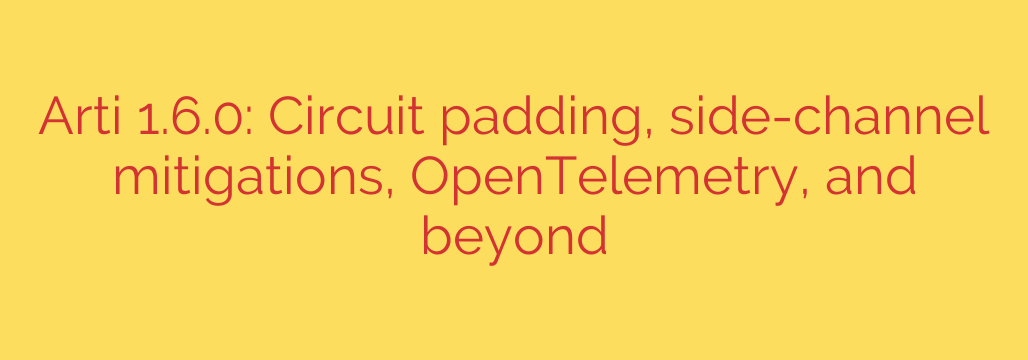
Next-Generation Anonymity: A Deep Dive into the Latest Tor Security Upgrades
In the ongoing mission to safeguard online privacy, the tools we use must constantly evolve to counter new and sophisticated threats. The Tor network stands as a pillar of digital anonymity, and its next-generation implementation in the Rust programming language, known as Arti, is pushing the boundaries of what’s possible. A recent major update has introduced a suite of powerful security features designed to harden the network against advanced surveillance techniques.
This isn’t just a routine update; it represents a fundamental leap forward in protecting user anonymity. Let’s explore the critical enhancements that make your connection more secure than ever before.
Defeating Traffic Analysis with Circuit Padding
One of the most significant threats to anonymous communication is traffic analysis. Even when data is fully encrypted, determined adversaries can analyze the patterns of traffic—the timing, size, and frequency of data packets—to deanonymize users or identify their online activity. This is often called “website fingerprinting,” where an attacker matches a user’s traffic pattern to a known website’s pattern.
To combat this, the latest update introduces a powerful defense mechanism: Circuit Padding.
This sophisticated technique works by adding small amounts of dummy data, or “padding,” to the encrypted traffic stream. By carefully inserting this cover traffic, the system can obscure the real patterns of user activity. The goal is to make different types of network activity look uniform and indistinguishable from one another.
Essentially, circuit padding acts as a form of camouflage for your data stream, making it significantly more difficult for an observer to guess what you are doing online. This proactive defense hardens the entire network against a class of attacks that have long challenged privacy systems.
Strengthening Defenses Against Side-Channel Attacks
Another subtle but dangerous threat comes from side-channel attacks. Instead of breaking the encryption itself, these attacks exploit secondary information leaked by a computer system, such as how long it takes to perform a cryptographic calculation. If an operation involving a secret key runs faster or slower depending on the key’s value, an attacker can measure these tiny time differences to eventually reconstruct the key.
To neutralize this threat, developers have focused on implementing constant-time cryptographic operations. This is a programming discipline where security-critical computations are written to always take the same amount of time to execute, regardless of the secret data being processed.
By ensuring this temporal consistency, the system eliminates the timing variations that attackers rely on, effectively closing the door on this covert method of extracting sensitive information. This is a meticulous, low-level enhancement that provides a powerful, high-level security guarantee.
Improving Network Health with Privacy-Preserving Telemetry
Running a complex, decentralized network like Tor requires robust monitoring and diagnostics to ensure reliability and performance. However, collecting this data poses a unique challenge: how do you monitor the system without compromising the very privacy it is designed to protect?
The solution is the new integration with OpenTelemetry, a standardized framework for collecting performance metrics and tracing data. This integration is carefully designed to be privacy-preserving. It allows developers and node operators to gain crucial insights into the health and behavior of the software—such as identifying bottlenecks or diagnosing errors—without ever accessing or logging user-specific data.
This enhancement is a critical step for the maturity and stability of the network, enabling faster troubleshooting and more efficient performance tuning while upholding the core principles of user privacy.
What This Means For Your Security
For users, these advancements translate directly into a more robust and resilient shield for your online activities. While these changes work deep within the software, they provide concrete protection against real-world threats.
Here are the key takeaways:
- Stay Updated: To benefit from these state-of-the-art protections, it’s crucial to ensure you are always using the latest version of your privacy software.
- Understand the Threat: Awareness of threats like traffic analysis and side-channel attacks helps you appreciate the importance of using tools that are actively developed and hardened against them.
- A Proactive Stance on Privacy: These updates demonstrate a forward-thinking commitment to not only responding to existing threats but anticipating and neutralizing future ones.
The fight for digital privacy is a continuous process of innovation and reinforcement. With these powerful new defenses, the foundation of online anonymity has become significantly stronger, ensuring users can communicate and browse with greater confidence and security.
Source: https://blog.torproject.org/arti_1_6_0_released/








